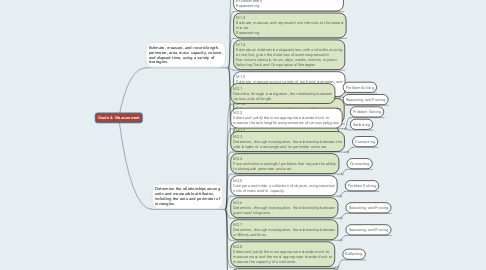Grade 4: Measurement
by Aaron Strong


1. Estimate, measure, and record length. perimeter, area. mass. capacity, volume, and elapsed time, using a variety of strategies.
1.1. M1.1 Estimate, measure, and record length, height, and distance, using standard units. Problem Solving, Reflecting
1.2. M1.2 Draw items using a ruler, given specific lengths in millimetres or centimetres. Representing
1.3. M1.3 Estimate, measure, and represent time intervals to the nearest minute. Representing
1.4. M1.4 Estimate and determine elapsed tiem, with and without using a time line, given the durations of events expressed in five-minute intervals, hours, days, weeks, months, or years. Selecting Tools and Computational Strategies
1.5. M1.5 Estimate, measure using a variety of tools and strategies, and record the perimeter and area of polygons. Selecting Tools and Computational Strategies
1.6. M1.6 Estimate, measure, and record the mass of objects, using the standard units of the kilogram and the gram. Problem Solving, Reflecting
1.7. M1.7 Estimate, measure, and record the capacity of containers, using the standard units of the litre and the millilitre. Problem Solving, Reflecting
2. Determine the relationships among units and measurable attributes, including the area and perimeter of rectangles.
2.1. M2.1 Describe, through investigation, the relationship between various units of length.
2.1.1. Problem Solving
2.1.2. Reasoning and Proving
2.2. M2.2 Select and justify the most appropriate standard unit to measure the side lengths and perimeters of various polygons.
2.2.1. Problem Solving
2.2.2. Reflecting
2.3. M2.3 Determine, through investigation, the relationship between the side lengths of a rectangle and its perimeter and area.
2.3.1. Connecting
2.4. M2.4 Pose and solve meaningful problems that require the ability to distinguish perimeter and area.
2.4.1. Connecting
2.5. M2.5 Compare and order a collection of objects, using standard units of mass and/or capacity.
2.5.1. Problem Solving
2.6. M2.6 Determine, through investigation, the relationship between grams and kilograms.
2.6.1. Reasoning and Proving
2.7. M2.7 Determine, through investigation, the relationship between millilitres and litres.
2.7.1. Reasoning and Proving
2.8. M2.8 Select and justify the most appropriate standard unit to measure mass and the most appropriate standard unit to measure the capacity of a container.
2.8.1. Reflecting
2.9. M2,9 Solve problems involving the relationship between years and decades, and between decades and centuries.
2.9.1. Problem Solving
2.10. M2.10 Compare, using a variety of tools, two-dimensional shapes that have the same perimeter or the same area.
2.10.1. Representing
